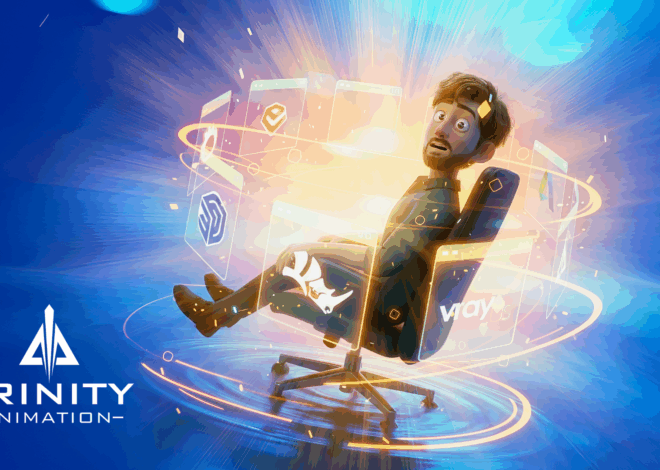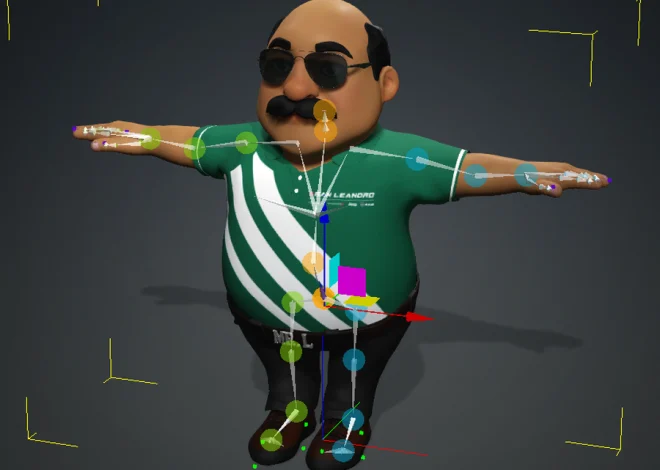
Behind The Scenes: Creating a Holiday Commercial for the Kansas Lottery
With the holidays around the corner, our animators have been getting into the spirit with our newest project for the Kansas Lottery produced by JNA Advertising. Keep reading to see the process of creating this commercial by mixing live action and animation.
Watch the Holiday Magic
Creating a Concept for the Commercial
The concept for the commercial was developed by JNA Advertising, who provided us with the script and overarching creative vision. Our role was to bring that vision to life through VFX, specifically, by creating a compelling look for the CG snow globe that would feel real within the live-action scenes. Our team had the opportunity to design the appearance and fine details of the snow globe itself.
This collaborative approach allowed us to focus on the technical and visual elements while staying true to the original concept, resulting in a final product that captured the spirit of the Kansas Lottery’s holiday campaign.
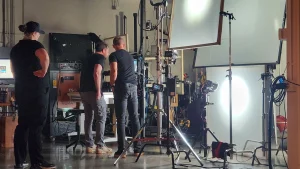
Each Step of the Process
The process from concept to completion for creating this commercial involved several meticulous steps.
First, we crafted a physical model, a painted wooden cylinder resembling the eventual digital snow globe. We added tracking markers to guide its replacement with the CG model later on.
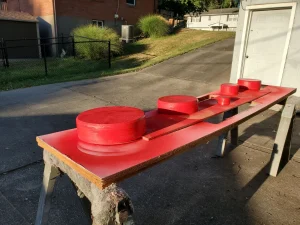
With our stand-ins prepped, we moved into filming, where actors interacted with these props as if they were real snow globes.
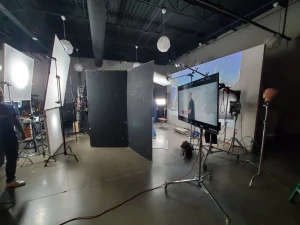
After filming, we moved into post-production, where our team motion-tracked the markers on the stand-ins. This step was crucial as it allowed us to overlay the digital snow globe model seamlessly, matching every nuanced motion, rotation, and hand-off precisely.
Then came the digital compositing, where we inserted the CG model, adjusted the lighting, color, and texture to blend naturally with the live-action background.
Finally, we fine-tuned colors, shadows, and reflections to ensure the digital snow globe looked like it belonged within the live-action scene. The final export showcased a cohesive, visually engaging scene that brings the holiday spirit to life.
Making the Props
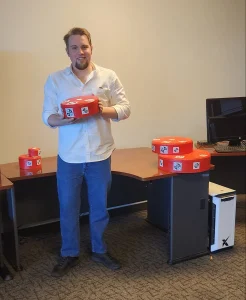
In preparation for the shoot, we handcrafted wooden props to represent the digital snow globe that would eventually replace them in post-production. Each wooden prop had to be cut, sanded, and carefully painted to match the exact shape, size, and color of the base for the final CG snow globe. This step wasn’t just about creating a placeholder, but about making an accurate physical reference for our VFX team. These props allowed actors to physically handle something tangible during filming. Once these props were ready, we added tracking markers to them.
Using Tracking Markers
The tracking markers on our snow globe props were essential for accurately inserting the CG model in post-production. These high-contrast black-and-white markers provided a consistent reference for the tracking software, allowing it to precisely gauge the position, orientation, and rotation of each prop throughout the scenes.
When editing, we used these markers to create a digital map of the prop’s movement, which then guided the placement of the CG snow globe. The markers tracked every tilt, pass, and rotation of the snow globe in the hands of the actors to be perfectly replicated by the digital model. By leveraging these tracking markers, we achieved a seamless integration that made the CG snow globe appear as a natural part of the live-action footage.
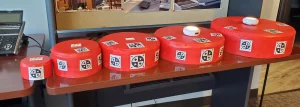
Working Behind the Scenes
Get a closer look into how we used our custom props to make movie magic on set.
Meticulously Making the Snow Globe Come to Life
One of the standout challenges in creating this commercial was achieving perfect movement matching between the live-action props and the CG snow globe. Even with tracking markers in place, there were moments where the tracking data wasn’t flawless. Subtle shifts or inconsistencies in lighting, reflections, or the way the props were handled sometimes created less-than-ideal tracking results.
In these instances, our VFX team had to jump in and manually correct any misalignment. This process involved meticulously adjusting the CG snow globe’s position, rotation, or scale, frame by frame, to keep it perfectly in sync with the actors’ movements. These manual fixes were time-consuming, but they were critical for maintaining the illusion of a real snow globe seamlessly passed between hands.
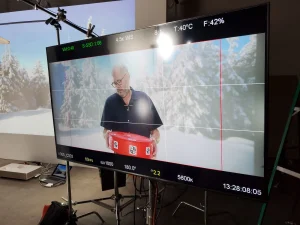
Blending Live Action and Animation
Filming with live actors adds a whole new layer of complexity to the animation process. Actors have natural, spontaneous movements that can be challenging to account for in post-production. Every slight adjustment affects the CG placement, meaning the VFX team has to be certain the digital snow globe perfectly matches these unpredictable movements. Even minor discrepancies would be noticeable and could potentially ruin the illusion.
Additionally, actors had to interact with the lightweight wooden prop as if it were a heavy, yet delicate snow globe. This meant that they had to consciously add a sense of weight to their movements, carefully adjusting how they lifted, passed, and held the prop.
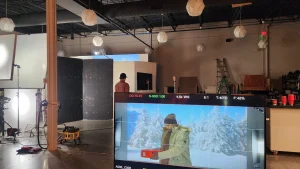
Utilizing the Right Software
To bring the CG snow globe to life, we primarily relied on two powerful software tools: 3ds Max and After Effects. Using 3ds Max, we modeled and animated the snow globe, crafting every detail from the swirling snow inside to the reflections on the glass. This software allowed us to create a photorealistic model that would seamlessly integrate with the live-action footage, and capture the intricate details you would find on a real snow globe.
After creating the CG elements, we moved the project into After Effects for compositing and final adjustments. Here, we aligned the digital snow globe with the footage, applying tracking data from the markers on our stand-ins. After Effects also allowed us to enhance colors, adjust lighting, and add subtle effects to make sure the digital snow globe felt completely embedded in the live-action environment.
A key innovation that made this commercial possible was our use of the GeoTracker plugin for After Effects, a relatively new tool designed specifically for tracking basic geometric shapes like cubes and cylinders.
GeoTracker’s advanced tracking capabilities meant that even with the simple cylindrical props, we could capture detailed positional and rotational data to guide our CG replacement. By using this plugin, we bypassed the usual tracking limitations and saved hours of manual work.
Let’s Work Together
For 30 years, Trinity Animation has excelled in creating high-quality medical, technical, marketing, interactive, and character animations! Partner with us for a full-service experience from concept to final delivery.
Contact us today for all your animation needs.
Written with the help of Matt Tyree and Nicholas Kaighen.

